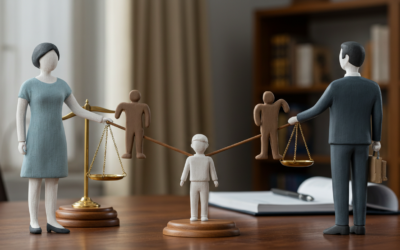Let’s say you’re walking down the sidewalk on a winter day when you slip on a patch of ice that the property owner failed to clear. Or perhaps you’re driving through an intersection when another vehicle runs a red light and t-bones you.
If you have been injured in an accident caused by someone else’s negligence, you may be entitled to compensation. However, Wisconsin follows a “comparative negligence” system, which can affect how much you receive. This guide from the attorneys at Vanden Heuvel & Dineen explains the fundamentals and provides practical guidance on managing injury claims.
At our firm, we have over 40 years of experience representing injury victims in eastern Wisconsin. We handle all types of personal injury cases and are committed to helping our clients recover the maximum compensation they deserve. If you believe your accident was caused by another party’s carelessness, contact us for a free case review.
Understanding Comparative vs Contributory Negligence
Negligence refers to a failure to exercise reasonable care that results in harm. Personal injury law often involves accidents where one party’s careless actions injure another.
Historically, “contributory negligence” meant that if the victim was even 1% to blame for their own injury, they lost the right to compensation. As you can imagine, this was unfair to many legitimate victims.
Under “comparative negligence,” both parties’ percentage of fault is considered. Victims can still recover damages, but the amount is reduced based on their share of responsibility. It is fairer and more nuanced.
For example, imagine a scenario where a pedestrian is jaywalking when a speeding driver hits them. Under contributory negligence, the pedestrian wouldn’t be able to recover any damages because they were partly at fault for jaywalking. Comparative negligence looks at the percentage of blame that lies on the speeding driver.
Wisconsin’s Modified Comparative Negligence Standard
Let’s zoom in on how things are done in Wisconsin. The state uses a “51% rule” for modified comparative negligence, which is based on Wisconsin Statutes section 895.045.
If the injured party is 51% or more at fault for their own injury, they cannot recover any damages. But if they are 50% or less to blame, their compensation is simply reduced by their percentage of fault.
We can revisit the pedestrian and car driver example from earlier. The court might deem that the pedestrian was 40% at fault for jaywalking. The driver shoulders 60% of the blame for speeding.
How Contributory Negligence Affects Payout
It’s important to note that the plaintiff’s recovery would be reduced by the percentage of negligence assigned to them.
In the example above, the compensation would be reduced by the pedestrian’s 40% fault. If their proven damages were $100,000 in medical bills and lost income, their payout would be lowered by $40,000. So, they would receive $60,000 or 60% from the driver’s insurance company.
That’s why most cases are handled by personal injury lawyers who can prove negligence.
Determining Fault and Liability in Injury Claims
As you can guess, the hard part lies in determining who is 51% at fault or more. Establishing each party’s fault percentage can be challenging. The court must review all evidence from both sides before assigning comparative responsibility.
To have a valid claim in Wisconsin, you must prove these key elements of negligence:
- Duty – The other party owed you a duty of care
- Breach of Duty – They failed in that duty
- Cause – Their failure directly caused your injury
- Damages – You suffered concrete health or financial harm
The Role of Evidence in Proving Comparative Negligence
Relevant evidence could include police reports, medical records, witness statements, photographs, bills and receipts, and more. A VHD Law attorney can help gather and present this evidence effectively to argue for lower fault assignment.
How Fault Percentages are Calculated in Wisconsin
In most cases, fault percentages are determined in court by a judge and jury. They will review all provided evidence and hear both sides of the story to determine the fault percentage for each party involved. This percentage is then used to calculate financial awards and damages.
Comparative Negligence in Different Injury Cases
Technically speaking, comparative negligence can be applied in any type of personal injury case. However, it’s most commonly seen in car accidents and slip and fall cases. Let’s take a closer look at how comparative negligence works in different types of injury claims.
Motor Vehicle Accidents
If both drivers’ actions contributed to a collision, comparative negligence allows for a fair distribution of fault percentages. Evidence is crucial in these “he said, she said” debates, so fault is often determined by looking at
- Who had the right of way
- Whether anyone was speeding or driving recklessly
- If any traffic laws were violated.
Premises Liability Cases
Where a dangerous property condition injures someone, the victim must prove the owner knew or should have known about the hazard. If a visitor was also partly careless, percentages can be split.
Product Liability Claims
If a defective product causes damage, the manufacturer may hold primary blame. But if the injured user fails to follow safety rules, they may share some responsibility.
Steps for Managing Your Injury Claim
Maneuvering a negligence claim under comparative fault rules can be challenging. We recommend injury victims take these key steps:
1. Contact an attorney immediately
The first step is to contact a lawyer to see if you have a strong case and advise you on how to proceed effectively. An experienced personal injury attorney can help you understand your rights and guide you through the claim process.
2. Gather relevant evidence and documentation.
Next, you must prove damages and support your version of events. The main goal here is to avoid allegations of higher fault percentages. Photograph injuries/property damage, obtain medical records, keep receipts, etc.
A lawyer can help you identify and collect the evidence needed to support your claim.
3. Explore settlement options
This step is done before deciding whether to go to trial. Many personal injury cases are resolved through settlement negotiations with the insurance company. However, insurance adjusters often try to lowball settlement offers, especially if they believe you were partially at fault.
A negotiator can deal with insurance adjusters and potentially resolve your case favorably out of court.
4. Go to trial
If a satisfactory settlement cannot be reached, partner with a trial lawyer to argue your case before a judge and jury. Representing yourself in court is rarely a good idea, especially if the opposing party has legal representation. Legal expertise is essential for achieving an optimal verdict or judgment.
Receive the Compensation You Deserve with VHD Law
Wisconsin’s comparative negligence law can make personal injury cases more complex, but with the right legal guidance, you can still receive the compensation you deserve.
The injury attorneys at Vanden Heuvel & Dineen are here to answer your questions and help you recover damages after an accident.
Contact us today to learn more and schedule your free case consultation.




